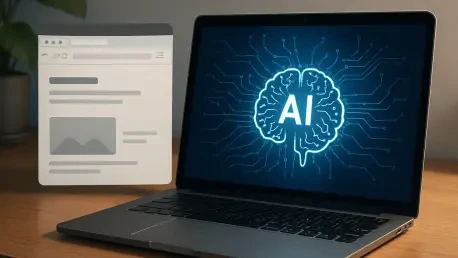Setting the Stage for AI in Hiring
Imagine a world where a job interview doesn’t just test memorized answers but mirrors the exact environment in which a candidate will work, complete with cutting-edge tools at their fingertips, transforming the way talent is assessed. This is no longer a distant vision but a reality in 2025, as artificial intelligence (AI) reshapes the recruitment landscape. AI-enabled job interviews, particularly in technical fields like software development, are emerging as a response to the demand for skills that align with modern workplace dynamics, challenging traditional hiring methods and raising questions about fairness and innovation.
The integration of AI into recruitment reflects a broader digital transformation in human resources, where efficiency and relevance are paramount. Companies are increasingly adopting these tools to simulate real-world tasks, ensuring candidates are evaluated on practical abilities rather than theoretical knowledge alone. This shift promises to redefine how talent is identified and nurtured in an era dominated by technological advancement.
This review delves into the core features, recent trends, practical applications, challenges, and future potential of AI-driven interview technologies. By examining pioneering efforts from industry leaders, the analysis aims to provide a comprehensive understanding of how this technology is reshaping hiring practices across sectors.
Core Features of AI Interview Technology
AI Assistants in Coding Evaluations
AI assistants have become a cornerstone of technical interviews, particularly in coding assessments, where they replicate the collaborative tools developers use daily. These assistants, integrated into interview platforms by leading tech firms, offer real-time support to candidates, guiding them through complex problems while monitoring their problem-solving approaches. This setup not only mirrors actual work environments but also curbs dishonest practices enabled by large language models, ensuring a more authentic evaluation of skills.
Beyond authenticity, these tools excel in creating a controlled testing space where candidates can demonstrate their technical prowess under realistic constraints. The effectiveness of AI assistants lies in their ability to provide hints or syntax support without solving problems outright, thus maintaining the integrity of the assessment. Current implementations show promising results, with many candidates reporting a more engaging and less stressful interview experience.
However, the performance of these tools is not without scrutiny, as their ability to accurately gauge a candidate’s true potential depends on the quality of AI algorithms and the fairness of their design. Continuous refinement is necessary to ensure they adapt to diverse coding styles and challenges, avoiding any unintended bias in evaluations. This balance of support and assessment remains a critical area for ongoing improvement.
Dual-Task Assessment Approaches
Another innovative feature of AI-enabled interviews is the adoption of dual-task evaluation methods, which simultaneously test a candidate’s fluency with AI tools and their core competencies for a specific role. This approach ensures that hiring processes value both technological adaptability and fundamental skills, reflecting the multifaceted demands of modern job roles. It aims to create a holistic picture of a candidate’s capabilities in a tech-driven world.
Balancing innovation with fairness is at the heart of these methods, as they strive to assess candidates on multiple dimensions without favoring those with greater access to advanced tools. By incorporating tasks that measure both AI interaction and independent problem-solving, employers can better understand how candidates might perform in real job scenarios. Yet, implementing such assessments across varied roles poses challenges, including the risk of overemphasizing tech skills in non-technical positions.
The real-world relevance of dual-task evaluations is evident in their ability to prepare candidates for hybrid work environments, but scalability remains a concern. Adapting these methods to roles outside technology requires careful calibration to ensure they do not alienate candidates unfamiliar with AI systems. Addressing these hurdles will be key to broadening the application of this promising assessment strategy.
Recent Trends in AI-Driven Recruitment
The landscape of AI integration in hiring is evolving rapidly, with significant initiatives setting benchmarks for the industry. One notable trend is the push by major tech companies to normalize AI use during interviews, treating it as a standard tool rather than a novelty. This shift, evident in current practices starting from 2025, indicates a growing acceptance of AI as an integral part of the recruitment toolkit, influencing how skills are tested and valued.
Employer and candidate behaviors are also adapting to this new reality, with both parties increasingly viewing AI tools as essential for demonstrating relevant competencies. There is a noticeable uptick in candidates preparing with AI assistants prior to interviews, while employers are revising job descriptions to include AI proficiency as a desirable trait. This mutual adaptation suggests a cultural shift toward embracing technology in every stage of the hiring journey.
Expert opinions further underscore the importance of evolving standards to keep pace with these developments. Many industry leaders advocate for clear guidelines that ensure transparency in AI use, preventing any perception of unfair advantage. The consensus points to a cautious optimism, where the benefits of AI in recruitment are acknowledged, provided they are accompanied by robust policies to maintain equity and trust across the board.
Practical Applications Across Industries
AI-enabled interviews are finding a firm foothold in technology and software development sectors, where the need for real-time problem-solving aligns seamlessly with AI capabilities. These industries have embraced simulated environments that allow candidates to interact with AI tools during assessments, reflecting the collaborative nature of modern coding projects. Such applications highlight the technology’s potential to bridge the gap between theoretical knowledge and practical execution.
A standout example is the approach taken by leading tech firms, which encourage mock AI-assisted interviews among their own employees to refine the process. This internal testing not only hones the technology but also builds confidence in its application, ensuring that it meets the needs of both interviewers and candidates. The focus on iterative improvement through real user feedback sets a strong precedent for other organizations looking to adopt similar systems.
Looking beyond tech, the scalability of AI interview tools to non-technical roles holds intriguing possibilities. While currently tailored for coding and data-driven positions, future adaptations could see AI supporting assessments in areas like marketing or customer service by simulating client interactions or strategic planning tasks. Expanding into these domains will require innovative design to ensure relevance and accessibility for a wider candidate pool.
Challenges and Limitations in Implementation
Despite the promise of AI in recruitment, ensuring fairness across diverse candidate demographics remains a significant challenge. Younger generations, often more adept with digital tools, may hold an edge over older candidates less familiar with AI systems, potentially skewing outcomes. Addressing this disparity calls for flexible evaluation options that accommodate varying levels of tech proficiency without compromising on role-specific requirements.
Transparency and trust are also critical concerns, as the opacity of AI-driven decision-making can erode candidate confidence. Without clear communication about how AI influences hiring outcomes, there is a risk of perceived bias, even if unintended. Employers must prioritize explainable AI models that demystify the assessment process, ensuring candidates understand the criteria behind evaluations.
Efforts to mitigate these issues are underway, with a focus on establishing policies that promote equitable hiring practices. Safeguards such as mandatory disclosure of AI use during interviews, coupled with standardized benchmarks for fairness, are being explored to level the playing field. These measures aim to build a framework where innovation does not come at the expense of integrity, fostering a more inclusive recruitment environment.
Future Outlook for AI in Hiring
The trajectory of AI in recruitment points toward broader industry adoption, with more companies likely to integrate these tools into their hiring processes over the coming years. As familiarity with AI grows, innovative assessment methods could emerge, focusing on personalized evaluations that adapt to individual candidate strengths and weaknesses. This trend promises to make interviews more tailored and relevant to specific job demands.
Technological advancements are expected to further refine AI tools, enhancing their ability to deliver fair and unbiased evaluations. Improvements in natural language processing and machine learning could enable more nuanced assessments, capturing subtle indicators of creativity and critical thinking. Such developments would strengthen the alignment between hiring practices and real-world skill requirements, benefiting both employers and job seekers.
The long-term impact on workforce dynamics is profound, as AI-enabled interviews could reshape candidate expectations and employer strategies alike. A greater emphasis on continuous learning and adaptability may become the norm, encouraging professionals to stay abreast of technological trends. This evolution will likely foster a hiring landscape where skills are not just tested but actively aligned with the evolving needs of a digital economy.
Reflecting on the Journey of AI in Recruitment
Looking back, the integration of AI into job interviews marked a pivotal shift in how talent was assessed and selected across industries. The technology demonstrated remarkable potential in mirroring real-world work environments, particularly in technical fields, while also revealing the complexities of balancing innovation with equity. Each advancement, from AI assistants to dual-task evaluations, contributed to a deeper understanding of modern skill sets.
Challenges such as fairness and transparency stood out as critical hurdles that demanded thoughtful solutions. Efforts to address these issues through clear policies and flexible assessment options laid the groundwork for more inclusive practices, even as the technology continued to evolve. The commitment to safeguarding trust remained a defining factor in the successful deployment of AI tools.
Moving forward, the focus should pivot to scaling these innovations responsibly, ensuring that AI in hiring becomes a tool for empowerment rather than exclusion. Stakeholders must collaborate on refining guidelines that prioritize candidate experience while embracing technological progress. By investing in explainable systems and equitable frameworks, the recruitment landscape can transform into a space where talent and technology coexist harmoniously, paving the way for a future of meaningful and fair evaluations.









